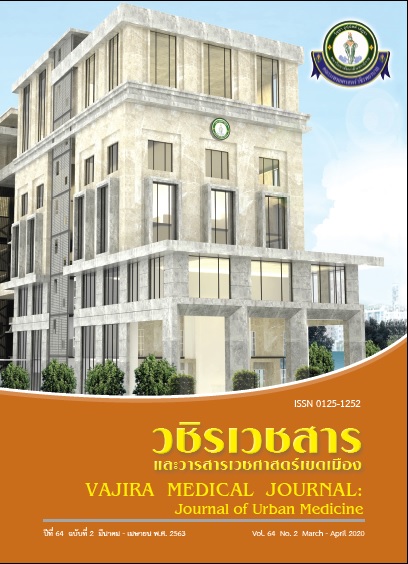Assess Level of Post-operative Pain in Adult Patients who Underwent Elective Surgery Using Pre-printed Postoperative Pain Order in Vajira Hospital
Main Article Content
Abstract
Objectives: To assess level of pain intensity (Numerical Rating Scale) in patients who underwent elective general surgery, colorectal surgery, urological surgery, ENT surgery, plastic surgery and orthopedic surgery at recovery room, arrival to ward, 4th, 8th, 16th, 32nd and 48th hour post-operatively using pre-printed post-operative pain order prescribed by surgeon. Secondary outcome is to study the incidence of serious adverse events after administering opioid such as deep sedation (Sedation Score=3) or respiratory depression (Respiratory rate <10/min) during using this pre-printed post-operative pain order protocol.
Study design: Descriptive study Subject: Data was obtained during January to March, 2017 with sample size of 370 patients. Methods: Personal and clinical information, types of surgery, anesthetic techniques and pain score at recovery room, arrival to ward, 4th, 8th, 16th, 32nd and 48th hour post-operatively were collected for analysis. Using descriptive statistics such as frequency, percentage, mean and standard deviation. Main outcome measures : Pain score at various time interval during 48 hours post-operative period.
Results : From 370 participants, 187 male patients (50.54%), median age was 54.3 ±14.82 years and 183 female patients (49.46%), median age was 55.5 ±14.96 years. Patients’ mean pain score at recovery room was 3.94 ±4.31, arrival to ward was 3.06 ±2.89, 4th hour post-operatively was 3.03 ±2.62, 8th hour post-operatively was 3.11 ±2.50, 16th hour post-operatively was 2.58 ±2.28, 24th hour post-operatively was 2.31 ±2.12, 32nd hour post-operatively was 1.89 ±2.10 and 48th hour post-operatively was 1.25 ±1.61 respectively. And during this study we found no incidence of serious complications regarding using opioid such as deep sedation or respiratory depression.
Conclusion : Patients who were prescribed post-operative pain order using pre-printed order by surgeon for elective general surgery, colorectal surgery, urological surgery, ENT surgery, plastic surgery and orthopedic surgery had mean pain score at recovery room 3.94 ±4.31, arrival to ward 3.06 ±2.89, 4th hour post-operatively 3.03 ±2.62, 8th hour post-operatively 3.11 ±2.50, 16th hour post-operatively 2.58 ±2.28, 24th hour post-operatively 2.31 ±2.12, 32nd hour post-operatively 1.89 ±2.10 and 48th hour post-operatively 1.25 ±1.61 respectively. And we found no incidence of serious complications regarding opioid administration for pain relief. Thus we support the usage of pre-printed post-operative pain order prescribed by surgeon in the hospital.
Downloads
Article Details
References
McNicol E, Horowicz-Mehler N, Fisk RA, Bennett K, Gialeli-Goudas M, Chew PW, et al. American Pain Society. Management of opioid side effects in cancer-related and chronic noncancer pain: a systematic review. J Pain 2003;4(5):231-56.
Schug SA, Large RG. Economic considerations in pain management. Pharmacoeconomics 1993;3(4):260-7.
Owen H, McMillan V, Rogowski D. Postoperative pain therapy: a survey of patients' expectations and their experiences. Pain 1990;41(3):303-7.
Warfield CA, Kahn CH. Acute pain management. Programs in U.S. hospitals and experiences and attitudes among U.S. adults. Anesthesiology 1995;83(5):1090-4.
Cepeda MS, Farrar JT, Baumgarten M, Boston R, Carr DB, Strom BL. Side effects of opioids during short-term administration: effect of age, gender, and race. Clin Pharmacol Ther 2003;74(2):102-12.
Principles of Analgesic Use in the Treatment of Acute Pain and Cancer Pain. 5th ed. Glenview, Ill.: American Pain Society, 2003.
Forman WB. Opioid analgesic drugs in the elderly. Clin Geriatr Med 1996;12(3):489-500.
McNicol E, Horowicz-Mehler N, Fisk RA, Bennett K, Gialeli-Goudas M, Chew PW, et al; Americal Pain Society. Management of opioid side effects in cancer-related and chronic noncancer pain: a systematic review. J Pain 2003;4(5):231-56.


